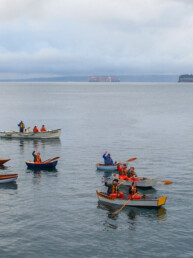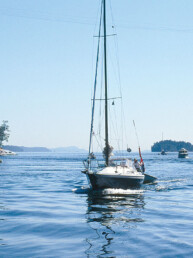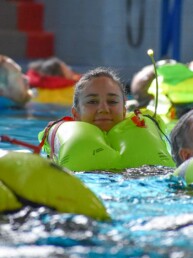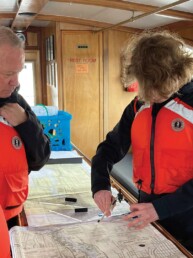Ask Bill Michael what he does for a living, and he’ll tell you that he hires and fires ferry captains for Washington State Ferries. Ask him what his meeting with a recent group of recreational sailors was all about and he’ll say this.
It was all about channel 16.
Michael, whose official duties as Port Captain include much more than personnel, was meeting with the Eagle Harbor Yacht Club, on Bainbridge Island. While other topics certainly came up, the one everyone wanted him to explain was why WSF never answers when you call them on 16.

If you have sailed these waters, or any waters, for that matter, you know that VHF channel 16 is the international hailing and distress frequency. Most recreational boaters know to monitor channel 16 while they are underway. But when you see a ferry bearing down on you and you’re not able to get out of the way for some reason, don’t call them on channel 16. They’re unlikely to hear you.
Michael revealed that WSF vessels have only just started carrying handheld VHF units that monitor channel 16. And those radios, he noted, may not be near the helmsperson. “If you called and no one answered, it’s because we didn’t hear you.”
Ferries do monitor two other VHF channels closely and continuously: 13, which is the “bridge to bridge” or inter-ship channel, and channel 14, which is the channel used by and devoted to Seattle’s Vessel Traffice Services (VTS). Seattle VTS controls and coordinates commercial traffic in Puget Sound south of the strait of Juan da Fuca. (North of there, in US waters, it’s VHF 05.)
You can reach that Puget Sound ferry on channel 13 or channel 14, and they will respond. It also follows that, if they end up sneaking up on you unawares, and blowing that dreaded five blast “immanent danger” horn, they likely tried to contact you on 13 or 14 and failed to do so.
The moral of the story is simple: When you are in Puget Sound waters, make sure that your onboard VHF scans channels 13 and 14, as well as 16.
The crowd in attendance was taken aback. Not a few found this a sorry state of affairs, and wanted to know why it could not be remedied. The short answer was money, and the lack therof.
The crowd’s surprise makes sense. As recreational boaters, we have grown used to calling our friends up on channel 16. Most of us then switch to a working channel for a conversation. Those of us who neglect to do so are informed by the Coast Guard (or some wiseacre on another recreational vessel) that they should take their conversation elsewhere. It seems natural that we would hail any other vessel on 16 first.
But commercial traffic needs to operate differently. The masters and pilots of those vessels use 13 and 14 only for quick conversations about the safe passage of their vessel. Channel 14 is also recorded by VTS. A collision of commercial traffic is likely to be reviewed very closely by any number of interested parties in the ensuing legal fracas.
Michael fielded a number of follow-up questions, some of them colored by a range of peeved to outraged tonalities, until one questioner asked why those bicycles always unloaded first, given that they slowed down the car traffic after them. He hesitated, surveyed the crowd on how many bicyclists were in the audience, and, finding very few, responded:
“So, the thing about channel 16 is–“
This post was originally published on Three Sheets contributor Stuart Scandron-Wattles’ blog On Board: On sailing the Salish. Go here to read more.






